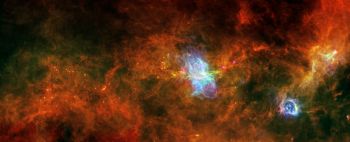Broadcast: News items
Space scientists help to reveal brilliant world of starburst galaxies
By: James Hakner
Last updated: Thursday, 6 December 2012

This new view of the Cygnus-X star-formation region by Herschel highlights chaotic networks of dust and gas that point to sites of massive star formation.

The Vela C region, part of the Vela complex, by ESA’s Herschel space observatory.
Sussex astronomers and space scientists in Hawaii have helped to reveal hundreds of previously unseen starburst galaxies – the birthplace of the stars that populate our Universe.
The number of starburst galaxies observed by the European Space Agency’s (ESA) Herschel space observatory and the ground-based Keck telescopes in Hawaii reveals the extraordinarily high star-formation rates across the history of the Universe.
Starburst galaxies give birth to hundreds of solar masses’ worth (ie stars or clusters of stars hundreds of times bigger in mass than our own Sun) of stars each year in short-lived but intense events. By comparison, our own Milky Way Galaxy on average produces the equivalent of only one Sun-like star per year.
Starburst galaxies generate so much starlight that they should outshine our Galaxy hundreds to thousands of times over, but the enormous quantities of gas fuelling them also contain vast amounts of dust as a result of the frantic star formation.
The dust absorbs much of the visible light, meaning that many of them look quite insignificant in that part of the spectrum. However, the dust is warmed by the surrounding hot stars and re-emits the energy at far-infrared wavelengths.
Using ESA’s infrared Herschel space observatory, astronomers measured the temperature and brightness of thousands of dusty galaxies. From these, their star-formation rate could be then calculated.
To understand how star formation has changed over the Universe’s 13.7 billion-year history, the distances to the galaxies were also needed.
University of Hawaii research leader Dr Caitlin Casey and her team used the Keck telescopes on Mauna Kea, Hawaii, to obtain redshifts of 767 of the starburst galaxies.
Redshifts provide astronomers with a measure of how long the light from each galaxy has travelled across the Universe, which, in turn, indicates when in cosmic history the light from each galaxy was emitted.
For most of the galaxies it was found that the light has been travelling towards us for 10 billion years or less. About five per cent of the galaxies are at even greater redshifts: their light was emitted when the Universe was only 1–3 billion years old.
“Starburst galaxies are the brightest galaxies in the Universe and contribute significantly to cosmic star formation, so it’s important to study them in detail and understand their properties,” says Dr Caitlin Casey of the University of Hawaii, lead author of the papers discussing the results in the Astrophysical Journal.
University of Sussex astronomer Professor Seb Oliver who, with Jamie Bock, leads the Herschel HerMES project that discovered these galaxies says: “The time scales of galaxy evolution are vast on a human scale, so we simply cannot watch galaxies change. The only way to study evolution is to compare censuses of galaxies at different epochs. That is why these large samples are so important.”
How such large numbers of starburst galaxies formed during the first few billions of years of the Universe’s existence poses a vital problem for galaxy formation and evolution studies.
One leading theory proposes that a collision between two young galaxies could have sparked an intense short-lived phase of star formation.
Another theory speculates that, when the Universe was young, individual galaxies had much more gas available to them to feed from, enabling higher rates of star formation without the need of collisions.

